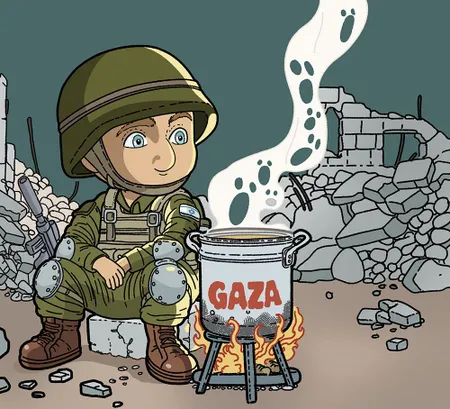SHARK Island is not an island, it’s a promontory. It reaches out as a half-curled arm to form Luderitz’s natural harbour. A breakwater between Namibia’s hard-baked desolation and waters made frigid by the southern Atlantic’s Benguela current sliding along the continent’s western edges. By day a freezer, by night a lament.
“Where’re you staying?” the coffee shop waitress asked. “I’m camping at the death camp.” Her face blanked. Gallows humour at the very least relies on a hanging’s knowledge. “Shark Island? Where the Germans killed the Nama and Herero,” I added.
“I wouldn’t know about that. I’m from Aus (135km from the port town),” she said.
“The forgotten genocide,” accepted shorthand for the Herero and Nama’s 1904-1908 near eradication, became the Nazi Holocaust’s template and a ghost haunting Israel’s “plausible” Gaza genocide shredding indigenous Palestinians.
The 300-metre waterless spit’s only shade or shelter from blinding sun and biting winds for the thousands condemned to a pitiful demise on Shark Island is a six-metre crevice, about 35cm at its widest and a few metres deep.
The crime scene stench has been wiped clean by seasonal drenching mists fomented by colliding temperature extremes. The mist also shrouds a near-century cover-up by German, British and white minority South African governments determined to censor the extermination camp’s existence.
Troop and trading ships edged past Shark Island’s wisps of humanity, picking through towering salt-polished boulders as the Herero and Nama succumbed to dehydration, starvation, disease, exhaustion, hypothermia, grief and despair. Drifting emaciated corpses undulating in a boat’s wake denied passengers and crew an alibi for genocide’s ghastly scent and complicity’s reckoning.
Lees hierdie artikel in Afrikaans:
Genocide amnesia
The chapter, spawning a souvenir cottage industry for polished Herero and Nama skulls among occupation soldiers and “racial scientists”, is a subplot to South Africa instigating genocide charges against Israel at The Hague’s International Court of Justice (ICJ).
The German government’s court intervention last month — endorsing Israel’s right to unleash a relentless bombing blitz on an overcrowded strip of land as a “proportional” response to Hamas’s October 7 atrocities — stoked memories of the colonial massacre.
Germany’s unquestioning support for Gaza’s obliteration was announced on the 120th anniversary of the outbreak of the 20th century’s first genocidal war. This anniversary passed unremarked by Berlin as it contested Pretoria’s “baseless” ICJ genocide claims that a victim can also be a perpetrator.
After authoring the “crimes against humanity of the Shoah” and expressing shame and repentance for creating and operating industrialised human abattoirs, Germany earned a sharp rebuke from Namibian President Hage Geingob a few weeks before he died on Sunday.
“The German government is yet to fully atone for the genocide committed on Namibian soil,” the 82-year-old president said in a statement. “Germany cannot morally express commitment to the (UN's) convention against genocide in Namibia while supporting the equivalent of a Holocaust and genocide in Gaza.”
Germany ramped up arms sales to Israel last year to $323 million (R6.1 billion) from the previous year’s $34 million (R646 million), most of it agreed after October 7, the German press agency DPA reported.
Germany conceded its forgotten genocide in 2021 but stopped short of paying reparations to victims' descendants — pitching an awkward curve ball questioning the deflection of Adolf Hitler’s Third Reich barbarism as a Western European “aberration”.
About 70% of indigenous land “ethnically cleansed” during the unrestrained bloodletting remains settled by German-Namibians or German nationals.
X marks the spot
Simmering tensions spilled into a shooting war on January 12, 1904 five weeks after the Herero dismissed a proposed treaty handing ancestral land to Germany. Okahandja’s station commander, Lieutenant Ralph Zurn, assuming the Herero illiterate, forged the paperwork with a string of patronising Xs.
Many Herero chiefs were fluent in the colonial language, easily able to read and write and more than capable of signing their names. The fraud ignited the resistance war primed by settler land invasions, rape, killings and graveyard desecrations wrapped in a coloniser's routine “sub-human” humiliations.
The day after Herero chief Samuel Maharero ordered the extermination of all white people — except for Basters, “Boers”, Damaras, English, Namas and German missionaries — 123 Okahandja German settlers and colonial Schutztruppe troopers were dead and an occupier’s military mystique was punctured.
The collective punishment meted out in response, including using the most modern weaponry available, lacing waterholes with poisons and establishing sjambok-ruled desert railroad chain gangs, killed about 80% of the 80,000 Hereros and more than half of the 20,000 Namas within four years.
Two explicit “annihilation” orders by the colony’s military commander, General Lothar von Trotha, enshrined genocidal intent. “Every Herero, with or without a gun, with or without cattle, will be shot,” said the first, making clear that this included women and children. Von Trotha signed-off a people’s destruction with the legend “The Great General of the Mighty Kaiser”.
A similar diktat was issued against the Nama the following year, 1905, to achieve the general’s ambition to “annihilate these masses with a simultaneous blow”.
Enter the dragon
Genocide denialism is a common condition. Former US president Bill Clinton’s administration skulked from confronting Rwanda’s 1994 Genocide by truncating the crime to the “G-word”, fearing uttering its full iteration compels it to act as a genocide convention signatory — which it does — even when describing old crimes with new words.
The April 7 onset of Rwanda’s 100-day genocide was diluted by the analogue age’s less nimble news coverage and by the international media distraction of apartheid’s final weeks and Nelson Mandela’s presidential ascent. Gaza’s alleged genocide is “live-streamed”, according to the South African government’s litigation in The Hague.
Palestinian writer Atef Abu Saif’s account of the Israeli Defence Forces' 2014 Gaza invasion — which killed 1,523 Palestinian civilians, including 519 children, in military operations euphemistically termed “mowing the lawn” — turned a city into a “charcoal drawing scorched by a dragon”.
“Blood was everywhere along with bits of kids' toys,” he writes, noting the Gazan habit of using permanent marker pens to inscribe their names on their bodies. “When death comes, at the very least our names will be on our graves.”
In The Drone Eats with Me: Diaries from a City Under Fire, the author recollects gathering limbs and other body parts from the street and “the smell of unretrieved bodies from a house hit last week. The more time passes, the stronger the smell.”
By some estimates, since Israel’s sledgehammer retaliation for October 7 as many as 30,000 Gazans have been entombed in rubble. Each has been accorded a bespoke timeline awaiting death’s relief and excluded from the official running body count averaging more than 150 daily.
Bakers, lovers and mothers, among other community fabric, crushed, mangled and decomposing beneath a home’s debris. An airstrike’s instant mass burial signposted by the unknown dead’s aroma.
Genocide’s odour crawls through the nose and throat, clawing at the lungs and forcing stinging eyes shut. It completes liquidation's macabre contorted poses by violating every sense.
Familiar journeys
The air thickened approaching a massacre site, prompting reporters during Rwanda’s genocide to repurpose scarves as face masks — a vain attempt to filter the pungent aerosol exuded by about 3,000 putrefying Tutsi remains a few hundred metres ahead.
The dead’s density increased as the four journalists slowly zigzagged through a maze of corpses. A Rwandan priest’s promise that a Roman Catholic Church was sacred ground and a safe haven from the 20th century’s “most efficient” genocide was the deceit that coaxed Tutsis from forest hideouts to feed executioners tripping on psychosis.
Rwanda’s butchery was mentored by the Interahamwe, an extremist Hutu nationalist militia revelling in hate’s faculties, enjoying widespread community participation as it killed more than 800,000 Tutsis and the Hutus who refused to join the bloodbath. Many were dismembered with pangas wielded by acquaintances, friends or neighbours during killing sprees monitored by Interahamwe militias for “satisfaction” and compliance.
Reporters stepped through a church’s lifeless congregation, studiously avoiding congealing puddles on a concrete floor from wall-to-wall bodies melding through rot in a stultifying heat. They took short, shallow breaths in their attempts to avoid inhaling a foul-smelling haze sliced by light shafts from fragmentation grenade-splintered stained glass windows.
A limp, beckoning hand protruding from an outhouse doorway betrayed another brimming body dump. The horror’s stillness was disturbed by reporters’ bent-double retching bouts. Unable and unwilling to accept the disgust.
Genocide’s oblivion is salted in the absurd. Radio Télévision Libre des Mille Collines reincarnated Tutsis as “cockroaches” in grievance-laden broadcasts bending Hutu society into “the willing executioners”.
Colonial and latter-day “racial scientists” chased their tails around melanin to invent a species divide; a whole people tarred and feathered “terrorists”, from newborns to geriatrics, rationalising genocide’s final distillation: “It’s them or us.”
Nazi chic
In 1922, Hitler bonded with a far-right band of embittered southern African veterans ruminating empire’s loss. He was entertained by first-hand accounts of Namibia’s killing fields and formed a good friendship with one of the group’s leader’s, General Franz von Epp.
Hitler’s “Brownshirt” street militia colour scheme was decided through Von Epp sourcing a heavily discounted job lot of Schutztruppe uniforms through his contacts.
It was a redundant military style after German colonies were shared as the spoils among World War 1’s victorious European powers. A colonial mindset’s street fashion was joined at the hip to the poster boy for genocidal philosophies.
Von Epp’s lieutenant-schooling during the Herero and Nama genocide gave Hitler privileged insight into a tried and tested blueprint to “deny a people’s right to exist”.
The colonial genocidaire recounted extermination’s record-keeping banality, the condemned’s cattle-truck transports and slave-labour concentration camps. The colonialists profited materially and ideologically from death’s shortcuts and when done exported the “specimen’s” brains to “race scientists” in jars of formaldehyde.
In The Kaiser’s Holocaust; Germany’s Forgotten Genocide, respected (and in some quarters reviled) historians David Olusoga and Casper W Erichsen observe “colonial genocide has always been a drawn-out process of massacres, famines, enslavement and hidden liquidations”.
The authors nominate Shark Island as inhumanity’s deepest pit for bringing “to life a new device: a military innovation that went on to become the emblem of the century … For here, on the southern edge of Africa, the death camp was invented.”
*Guy Oliver reported from Kigali during the 1994 Rwandan genocide.
♦ VWB ♦
BE PART OF THE CONVERSATION: Go to the bottom of this page to share your opinion. We look forward to hearing from you.







To comment on this article, register (it's fast and free) or log in.
First read Vrye Weekblad's Comment Policy before commenting.